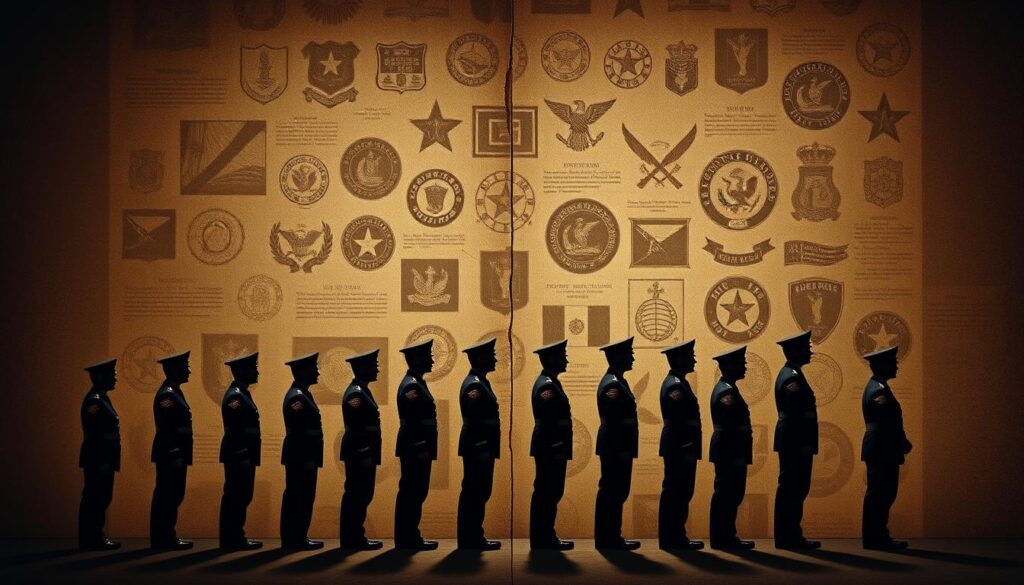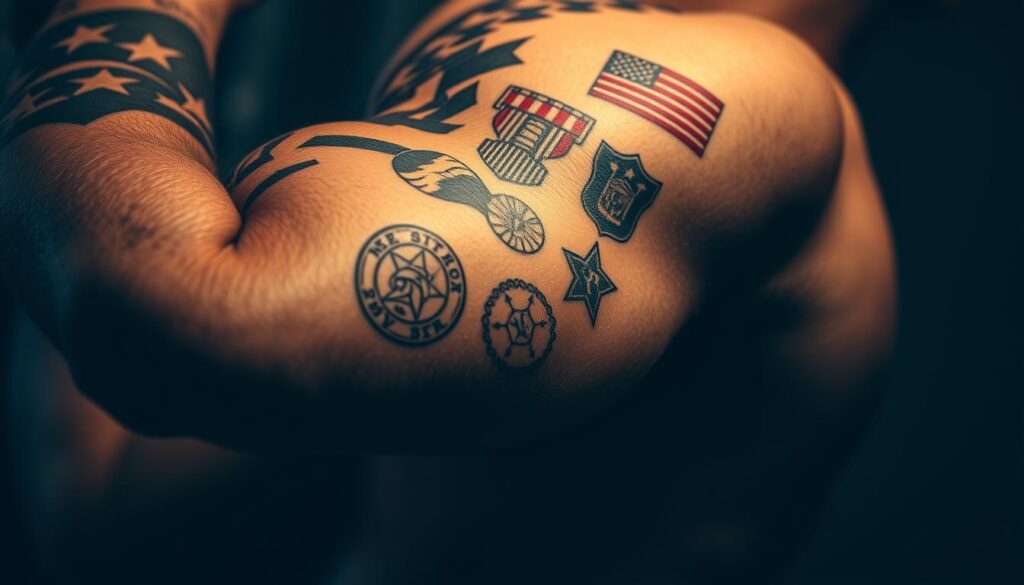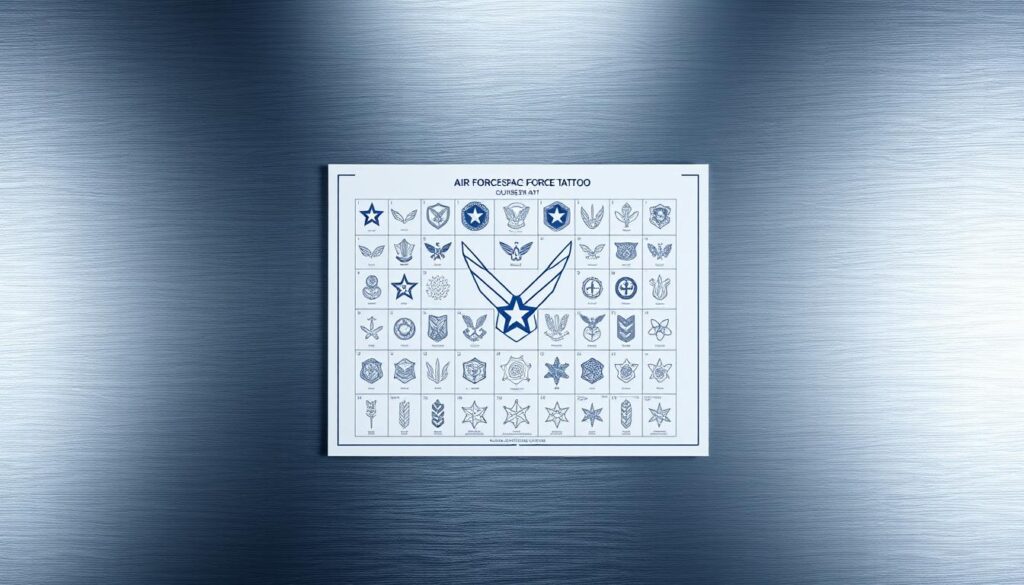
What if your tattoos could actually help you serve your country? That’s not a trick question—it’s a reality since June 2022, when the U.S. military updated its appearance standards. For decades, strict rules limited where service members could display body art. Now, those guidelines have shifted to reflect modern values and recruitment needs.
The changes allow ink in areas previously off-limits, like hands and parts of the neck. You can now have one tattoo per hand (under 1 inch) and small designs behind each ear or on the upper neck. This flexibility helps many aspiring recruits avoid lengthy waiver processes that once delayed enlistment.
But there’s a catch. While placement rules relaxed, content restrictions remain strict. Symbols tied to extremism, discrimination, or explicit imagery still disqualify candidates. The goal? Balance personal expression with the professionalism required in uniform.
Key Takeaways
- Updated standards permit small hand, neck, and ear tattoos since 2022
- Content bans include offensive or extremist imagery
- Changes aim to attract more qualified candidates
- Face tattoos remain prohibited
- Rules vary slightly between military branches
Understanding the Evolution of Military Tattoo Policies

The journey from banned ink to accepted expression in uniform mirrors broader cultural shifts. For centuries, strict codes prioritized uniformity over individuality, viewing body art as incompatible with disciplined service. But as societal norms evolved, so did these regulations.
Historical Perspectives on Military Appearance
Early standards focused on projecting unwavering order. Commanders believed visible markings could undermine authority or suggest rebellion. One retired officer noted: “We weren’t just training soldiers—we were shaping symbols of national pride.”
Three factors drove these rules:
- Preserving group cohesion through identical uniforms
- Maintaining public trust in military professionalism
- Upholding traditions dating to 18th-century European armies
Modern Acceptance and Changing Traditions
By 2019, nearly half of adults under 35 had body art. Recruitment offices faced a dilemma: reject skilled applicants over ink or adapt. The Navy led the shift, drawing from its sailor heritage where tattoos symbolized maritime milestones.
Today’s approach balances two priorities:
- Attracting tech-savvy recruits who value self-expression
- Ensuring markings don’t distract from mission readiness
This evolution shows how appearance standards now reflect both discipline and demographic realities, proving traditions can adapt without crumbling.
General Guidelines for Tattoos in the U.S. Military

Your body art tells a story, but does it meet military standards? While each service branch has unique details, five core principles apply to all recruits. These shared rules create consistency while allowing some flexibility.
Content, Size, and Visibility Restrictions
Every design gets scrutinized for meaning. Symbols linked to hate groups, explicit content, or illegal activities will disqualify you immediately. Even subtle references to drugs or gangs can raise red flags during screening.
Location matters as much as message. No markings can appear on your face, scalp, or inside eyelids. One Navy recruiter put it bluntly: “We’re building a team, not a gallery—certain areas stay clean.”
| Branch | Content Rules | Size Limits | Visible in Uniform? |
|---|---|---|---|
| Army | No extremist symbols | Hand: 1 inch | Yes (except face) |
| Navy | No vulgar language | Neck: 1×3 inches | Yes |
| Marine Corps | No gang signs | Finger: 3/8 inch | Limited |
Size requirements vary by body part. Sleeves are generally acceptable if they don’t peek past uniform sleeves. Most services now allow visible ink below the collarbone if designs aren’t distracting.
Remember: Commanders have final say. A harmless-looking symbol in civilian life might violate military decorum rules. When in doubt, ask a recruiter before enlisting.
Army Tattoo Policy: Key Rules and Considerations

Got ink? The Army might welcome it—if you know where to put it. Recent updates offer clearer pathways for recruits with body art while maintaining professional standards. Let’s break down what’s allowed and how to address existing markings.
Tattoo Placement and Size Limits in the Army
Your sleeve designs get a green light—no restrictions on arm coverage. Want something more visible? Here’s the breakdown:
| Body Area | Quantity | Max Size | Visibility |
|---|---|---|---|
| Hands | 1 per hand | 1 inch | Allowed |
| Neck (back) | 1 | 2 inches | Uniform collar |
| Behind ears | 1 per ear | 1 inch | Partially visible |
Finger webbing works if designs stay hidden when fingers close. Face markings? Still banned. No exceptions for eyelids, mouth, or scalp areas.
What to Do If Your Design Doesn’t Meet Guidelines
Found a conflict? Don’t panic. First, consult a recruiter about waiver options—some exceptions apply for skilled candidates. Second, consider professional removal or cover-ups for small non-compliant pieces.
“We work with applicants to find solutions,” says Staff Sgt. Maria Reyes, a career counselor. “It’s about matching talent with standards.”
Remember: Content rules trump placement. Even approved locations can’t display extremist symbols or offensive imagery. When in doubt, get pre-approval before enlisting.
Comparing Tattoo Policies Across Different Military Branches

Choosing where to serve often comes down to matching your personal style with branch-specific rules. While all services value professionalism, their approaches to body art vary widely—especially for visible markings.
Navy and Marine Corps: Unique Guidelines Explained
The Navy leads in flexibility, honoring its sailor heritage. You can display full sleeves and one ring design per hand, plus neck ink under 1 inch. A career counselor notes: “We view body art as part of naval tradition, not a distraction.”
Marines take a stricter stance. While sleeves are allowed, they must stop at the wrist and collarbone. Neck markings? Completely off-limits. This reflects their focus on uniformity and disciplined presentation.
| Branch | Body Area | Quantity | Size Limit |
|---|---|---|---|
| Navy | Neck | 1 | 1 inch |
| Marine Corps | Hand | 1 | 1 inch |
| Coast Guard | Finger | 1 per hand | Between knuckles |
Coast Guard and Other Service Differences
Coast Guard rules strike a balance. You get one 1-inch marking per hand that stops at the first wrist knuckle. Finger designs are permitted between knuckles, and ring tattoos skip thumbs entirely.
Air Force and Space Force recently eased restrictions too, but their updates deserve separate exploration. For now, remember: your existing ink might qualify in one branch but not another. Always verify before committing.
Updates and Relaxations in Air Force and Space Force Tattoo Policies

Freedom in the air now extends to body art. The Air Force and Space Force lead military branches with updated standards that prioritize skill over skin. These changes reflect a strategic shift to attract specialists in cybersecurity, engineering, and space operations—fields where talent often comes with personal expression.
New Trends in Tattoo Regulations
Here’s what sets these branches apart:
- No quantity limits: You can have full sleeves, back pieces, or multiple designs as long as content stays professional
- Hand freedom: Single ring markings under 3/8 inch width per hand are approved
- Neck and ear options: 1-inch designs allowed behind ears or on the upper neck
Face markings remain off-limits except for permanent cosmetics like eyebrow microblading. A Space Force recruiter explains: “We’re recruiting coders and satellite experts—their expertise matters more than ink placement.”
Both branches share identical rules to simplify recruitment. Whether you choose aircraft or orbit operations, your existing body art likely won’t disqualify you. This approach has helped boost applications by 18% since 2023, according to service reports.
Just remember: extremist symbols or offensive imagery still violate standards. Your favorite band logo? Probably fine. A controversial political slogan? Red flag. When in doubt, ask for pre-approval through official channels.
Impact of Tattoo Regulations on Military Recruitment
Imagine walking into a recruiting office knowing your personal art might shape your career path. Updated appearance standards now influence enlistment decisions more than ever, with over 650 waivers processed in early 2022 alone. These changes reflect shifting priorities in building tomorrow’s force.
Recruitment Strategies and Waiver Options
The waiver process takes roughly two weeks but remains a double-edged sword. While offering exceptions for skilled candidates, it risks losing recruits to branches with friendlier policies. One career specialist notes: “We’re racing against both clock and competition when reviewing body art requests.”
Services now prioritize talent retention through:
- Streamlined approval for cyber and technical roles
- Pre-screening tools to assess design compliance
- Collaboration with removal clinics for small adjustments
How Tattoo Policies Affect Young Recruits
41% of 18-24 year-olds consider body art when choosing service branches, per Army research. This demographic views ink as personal branding – a dealbreaker if regulations feel outdated.
Modernized rules help bridge the civilian-military culture gap. As one recruit shared: “My sleeve tells my story, but I want it to align with my service too.” Balancing self-expression with tradition remains key to attracting Gen Z volunteers.
